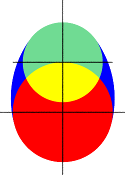Difference between revisions of "Reference:Ovus"
Le Forgeron (talk | contribs) m (Adding precision about the minor radius of the lemon, at request of C-Lipka in p.general) |
Le Forgeron (talk | contribs) m (remove the term citrus for lemon (the correct one).) |
||
| Line 15: | Line 15: | ||
<tr> | <tr> | ||
<td width="290px"> | <td width="290px"> | ||
| − | <p>Where <em><code>Bottom_radius</code></em> is a float value giving the radius of the bottom sphere and <em><code>Top_radius</code></em> is a float specifying the radius of the top sphere. The top sphere and the bottom sphere are connected together with a suitably truncated | + | <p>Where <em><code>Bottom_radius</code></em> is a float value giving the radius of the bottom sphere and <em><code>Top_radius</code></em> is a float specifying the radius of the top sphere. The top sphere and the bottom sphere are connected together with a suitably truncated lemon (self intersection of a torus), that is automatically computed so as to provide the needed continuity to the shape.</p> |
</td> | </td> | ||
<td>[[Image:RefImgOvus2D.png|center|125px<!--left--->]]</td> | <td>[[Image:RefImgOvus2D.png|center|125px<!--left--->]]</td> | ||
Revision as of 19:07, 5 May 2016
An ovus is a shape that looks like an egg. The syntax of the ovus object is:
OVUS:
ovus {
Bottom_radius, Top_radius
[OBJECT_MODIFIERS...]
}
|
Where |
|
|
An ovus 2D section |
The ovus and it's constituent 3D shapes |
Whenever the top radius is bigger than twice the bottom radius, the ovus degenerates into a sphere with an offset center. There are a lot of variations in the shape of the ovus.
Note: According to the ratio of the radius, the pointy part is the smallest radius, but is not always on top!
Evolution of ratio from 0 to 1.95 in 0.15 steps. |
Note: See the following MathWorld references for more information about the math behind how the ovus object is constructed.


